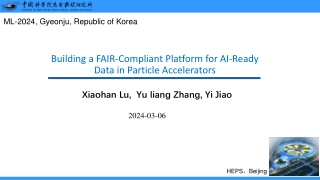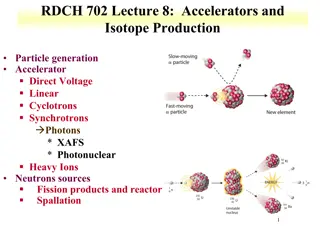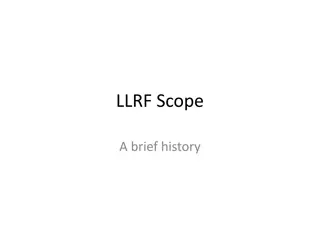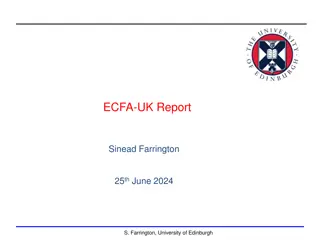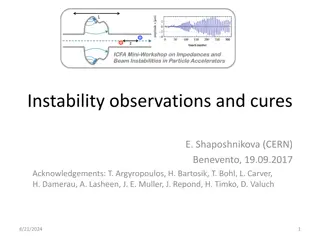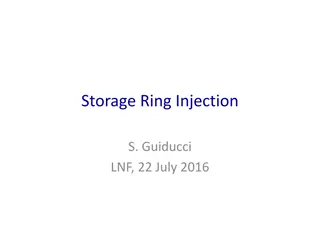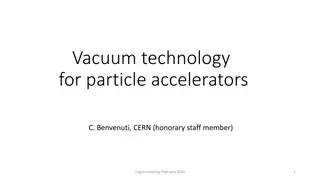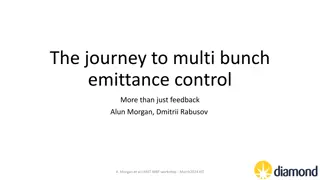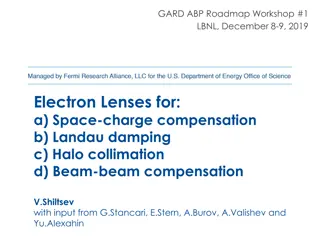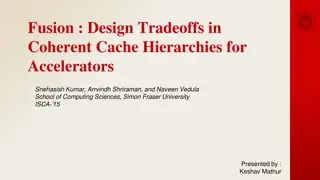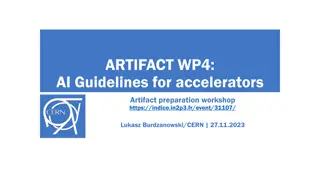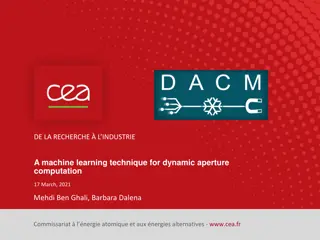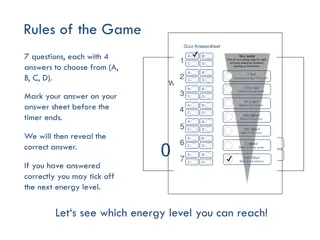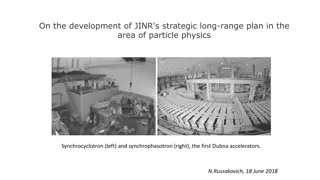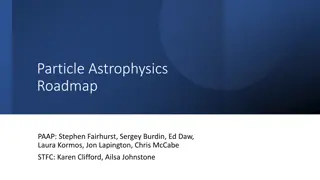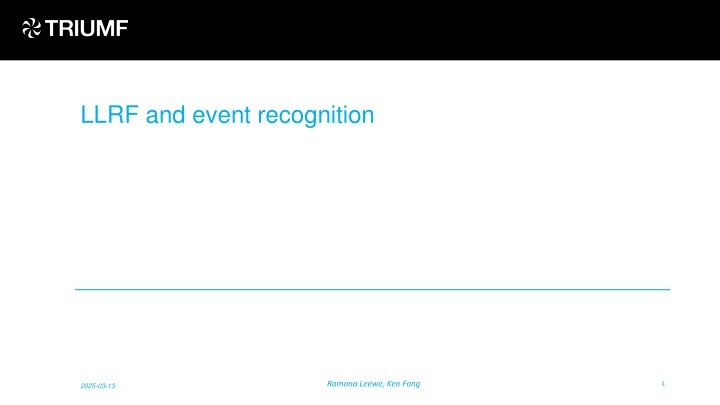
Introduction to LLRF and Event Recognition in Particle Accelerators
LLRF (Low-Level Radiofrequency) plays a critical role in synchronizing RF fields with particles in particle accelerators. This article discusses the importance of LLRF and the need for event recognition systems in maintaining stability and minimizing perturbations. It also explores machine learning applications in accelerator technology, including fault detection and prevention. Components involved in LLRF systems and the impact of perturbations on RF fields are covered, along with the role of tuners, couplers, amplifiers, and transmission lines in LLRF controls.
Download Presentation

Please find below an Image/Link to download the presentation.
The content on the website is provided AS IS for your information and personal use only. It may not be sold, licensed, or shared on other websites without obtaining consent from the author. If you encounter any issues during the download, it is possible that the publisher has removed the file from their server.
You are allowed to download the files provided on this website for personal or commercial use, subject to the condition that they are used lawfully. All files are the property of their respective owners.
The content on the website is provided AS IS for your information and personal use only. It may not be sold, licensed, or shared on other websites without obtaining consent from the author.
E N D
Presentation Transcript
LLRF and event recognition Ramona Leewe, Ken Fong 1 2025-03-13
Outline What is LLRF and why do we need it? Importance of an event recognition system in LLRF Event recognition through Machine Learning/ Machine Learning in the field of particle accelerator First steps: Spark detection in TRIUMF s cyclotron Ramona Leewe, Ken Fong
What is LLRF and why do we need it? Beam travelling along the beam pipe from the low energy section to the high energy section and gains its energy in the different acceleration structures such as he RFQ or DTL Field needs to be synchronized with the travelling particles Ramona Leewe, Ken Fong
What is LLRF and why do we need it? PI feedback is the classical way to deal with random perturbation Main goal: maintain the stability of the RF field, and minimize the required overhead power. RF field depends on: Amplitude Phase Frequency Cavity tuning Feedforward is the classical way to deal with repetitive perturbations Field stabilization Perturbations can be seen everywhere in an accelerator and affect the Amplitude, Phase and Frequency Power supply Temperature drifts Microphonics ect. Beam loading Lorentz force detuning ect. Ramona Leewe, Ken Fong 4
Components involved in a LLRF system tuners couplers amplifiers cavity transmission lines LLRF controls cryogenics Ramona Leewe, Ken Fong
Components involved in a LLRF system tuners couplers amplifiers cavity transmission lines LLRF controls cryogenics Ramona Leewe, Ken Fong
Components involved in a LLRF system tuners couplers amplifiers cavity transmission lines LLRF controls cryogenics Ramona Leewe, Ken Fong
Machine learning in the field of particle accelerators Ramona Leewe, Ken Fong 8
Fault detection and prevention through machine learning; example EUXFEL: so far quench detection realized through loaded Q measurement Realization: Build a cavity model including Lorentz force and beam loading Create residuals/error signal through comparison of simulation and measurement (database with quenches must be available) Plot the residuals with respect to each other Clusters within the plot suggest decision boundaries for online operation Results: Anomalies could be detected on an example set successfully So far online operated offline, real time anomaly detection to be tested Q threshold L Problem: Quench detection after it happened New idea: Anomaly detection of the field to prevent a quench from happening? Machine learning and fault detection in the field of particle accelerators Ramona Leewe 9
Fault detection for TRIUMFs cyclotron/ spark detection Part of the cyclotron LLRF system upgrade Spark detection so far: Idea: Can we use machine learning to identify a spark? Can we detect where it occurred in the system? Different approaches: Spark indication: Abrupt fall of the Dee voltage, increase in reversed power Model based Requires good knowledge of the system, exact modelling is important Spark detection through rate of change of the Dee voltage: the rate of change of the Dee voltage is measured Categorized in Small - RF drive unchanged Medium - RF drive switched off + quick start Large - RF drive switched off + normal start Non model based Supervised machine learning requires manual classification of each event and then trains a neural network Classification problematic, system can be damaged if not switched off Machine learning and fault detection in the field of particle accelerators Ramona Leewe 10
Fault detection for TRIUMFs cyclotron/ spark detection Part of the cyclotron LLRF system upgrade Spark detection so far: Idea: Can we use machine learning to identify a spark? Can we detect where it occurred in the system? Different approaches: Spark indication: Abrupt fall of the Dee voltage, increase in reversed power Model based Requires good knowledge of the system, exact modelling is important Spark detection through rate of change of the Dee voltage: the rate of change of the Dee voltage is measured Categorized in Small - RF drive unchanged Medium - RF drive switched off + quick start Large - RF drive switched off + normal start Non model based Supervised machine learning requires manual classification of each event and then trains a neural network Classification problematic, system can be damaged if not switched off Machine learning and fault detection in the field of particle accelerators Ramona Leewe 11
Model-based Spark Classification/ available data from TRIUMFs cyclotron Through oscilloscope captured events (more than 68000 images stored) RF drive Dee Voltage Tx pick up Reversed power Machine learning and fault detection in the field of particle accelerators Ramona Leewe 12
Model-based Spark Classification/ available data from TRIUMFs cyclotron Through oscilloscope captured events (more than 68000 images stored) Spark events Machine learning and fault detection in the field of particle accelerators Ramona Leewe 13
Model-based Spark Classification/ available data from TRIUMFs cyclotron Through oscilloscope captured events (more than 68000 images stored) Spark events Change of amplitude Machine learning and fault detection in the field of particle accelerators Ramona Leewe 14
Model-based Spark Classification/ available data from TRIUMFs cyclotron Through oscilloscope captured events (more than 68000 images stored) RF switched on Spark events Change of amplitude Machine learning and fault detection in the field of particle accelerators Ramona Leewe 15
Model-based Spark Classification/ available data from TRIUMFs cyclotron Through oscilloscope captured events (more than 68000 images stored) RF switched on Spark events Change of amplitude RF switched off Machine learning and fault detection in the field of particle accelerators Ramona Leewe 16
Model-based spark identification/ cyclotron model Matlab/Simulink toolbox simscape Machine learning and fault detection in the field of particle accelerators Ramona Leewe 17
Model verification Spark within the resonator RF drive being switched off Measurement signals are reconstructed from scope images through a Matlab script Machine learning and fault detection in the field of particle accelerators Ramona Leewe, Ken Fong 18
Residual generation Yellow data trace used for pre classification Residual calculation Pre classification based on the RF drive in RF on RF off For in increase of the RF drive ( ( ) 2 = r y ysim 1 RFon ) 2 = r y ysim 2 RFonfailed For a decrease of the RF drive ( ( ) ) 2 = r y ysim 3 RFoff 2 = r y ysim 4 spark Machine learning and fault detection in the field of particle accelerators Ramona Leewe, Ken Fong 19
Residuals for 400 captured events Clear cluster separation for both plots Increase of RF drive All other events are located in the upper plot. Other events include: Increase in reversed power due to frequency mismatch (e.g. temperature changes) Change of operating field amplitude Builds the foundation for a deeper analysis for spark events or failed RF on events Decrease of RF drive Machine learning and fault detection in the field of particle accelerators Ramona Leewe, Ken Fong 20
Summary and Outlook Summary Outlook, next steps Analysis of spark diagnostic with respect to the location where they occurred How does a spark develop in vacuum? Add signals like the reversed power or the transmission line signal Long term goal: Online classification and real time reaction system Other Machine Learning application within LLRF, e.g. Failed cyclotron start up events Improved start up sequence The existing images can be categorized with respect to RF on successful RF on failed RF off events Sparks Other events Ramona Leewe, Ken Fong 21
Thank you for your attention! Ramona Leewe, Ken Fong 22

